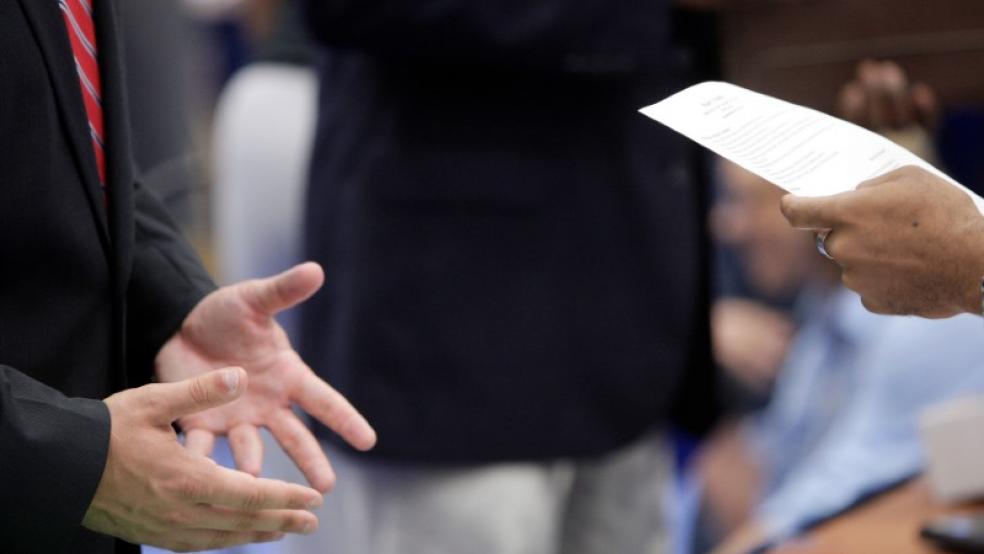On Friday, with the release of the January jobs report, President Trump’s administration got its first look at the baseline by which many will judge the new president in the future.
The comparisons may or may not be fair. The policies of a president’s predecessor may have lingering effects that last well into or even throughout their term in office. Trump supporters can and will argue that enthusiasm about his impending presidency sparked growth in the months following his elections.
Related: Populist on the Trail, Trump Pivots Toward the Banking Industry
Additionally, global events -- war, natural disaster, foreign economic crises -- can all affect the U.S. economy in ways a president has little control over. And the level of cooperation a president gets from lawmakers is a tremendous factor in determining the degree to which White House policies are able to affect the economy.
But for Trump -- who declared that he would be “the greatest jobs president God ever created” during his campaign and has repeatedly said that employment growth will be his singular focus while in office -- there will be no escaping the job market comparisons. Even more than other presidents, he will be called to account for job-related failures and feted for job-related successes over the next four years.
So, it’s worth treating the Bureau of Labor Statistics “Employment Situation Summary” for January as a marker for the transition from the Obama economy to the Trump economy.
By most but not all measures, the economy Trump inherits is healthy and robust.
Related: Good News, Bad News for Trump as the Economy Picks Up Steam
U.S. businesses created 227,000 non-farm jobs in January, making it the 76th consecutive month of positive job growth, the longest streak ever recorded. It was also well above the average 187,000 jobs the economy created every month in 2016. Because of Trump’s emphatic promises to bring back manufacturing jobs to the United States, it’s worth noting that even in a strong month of growth, the economy added just 5,000 jobs in that sector.
The official unemployment rate, which measures the percentage of people who were actively seeking work in the month of January but were unable to find it, sits at 4.8 percent, or about 7.6 million people. That is at or near the level most economists consider the “natural” rate in a healthy economy.

However, there were another 5.8 million people considered “employed” in the survey who reported that they were actually only working part time, even though they would prefer full-time employment. That’s fewer than a year ago, but is still high by historic standards.
About 1.9 million of the unemployed are considered long-term jobless, meaning they have been out of work for six months or more. That figure has been declining slowly but steadily for several years now.
Stepping back, another 1.8 million were considered “marginally attached” to the workforce, meaning they did not look for a job in January, but would like to work and have sought employment in the past 12 months. Among those, 532,000 were “discouraged” workers, who said that although they would like to work, they have given up looking entirely.
Related: The GOP’s ‘Repeal and Replace’ Obamacare Is Becoming ‘Repair and Fix’
The labor force participation rate, a number Trump focused on in his campaign, continued to improve, rising 0.2 percent to 62.9 percent. After a years-long decline, the percentage of Americans in the workforce appears to have stabilized at around 63 percent. That is still low by historic standards, but much of the decline is attributable to an aging population.
Wage growth was positive but slow, rising $0.03 to $26 per hour, a 2.5 percent year-over-year increase.
When pundits and voters -- and potential challengers -- start taking stock of Trump’s performance in advance of the 2020 elections, these are the numbers that they will use as the baseline. Just as it was normally noted that President Obama took office at a time when the country was shedding 800,000 jobs every month, people will point out that Trump took office with steady growth and most indicators moving in the right direction, if slowly.
In a sense, he may have a harder task ahead of him than Obama did. By the time he ran for reelection in 2012, the economy wasn’t roaring, but at least the president had a story to tell. He was able to point to two straight years of solid job growth and a declining unemployment rate. He could plausibly tell Americans that the once fearful prospect of a full-on depression was no longer a worry and that the country was indisputably on the mend.
Related: Trump May Try to Weed Out Immigrants Who Cost Taxpayers $279 Billion Annually
However much he wants it, Trump probably isn’t going to be able to tell a credible ‘turnaround’ story like that four years from now.
Unless you believe his promises to drive U.S. economic growth rates above 4 percent, which most economists do not, Trump will likely be telling a tale of incremental progress at best. If he can maintain employment and wage growth at current rates, chipping away at the number of underemployed Americans and drawing others back into the workforce, the narrative will be positive, just not terribly dramatic.
Unfortunately for Trump, he’ll have to do it while butting up against a lower bound in the unemployment rate, and in the face of a Federal Reserve that is likely to spend the next several years gradually increasing interest rates from their current rock-bottom levels.
It’s a tough task, but hopefully nothing the “best jobs president God ever created” can’t handle.





